Beef lo mein: a savoury combination of tender beef, silky noodles, and vibrant vegetables that has become a beloved staple in Chinese-American cuisine.
This delightful stir-fry dish combines the rich flavours of marinated beef, the umami-packed sauce, and the satisfying chewiness of lo mein noodles, blending to create a dish that has won the hearts and palates of food enthusiasts worldwide.
In this article, we will take a flavourful journey into the origins, preparation, and art of perfecting beef lo mein, inviting you to discover the secrets behind this delectable culinary masterpiece. Whether you are a novice in the kitchen or a seasoned chef, join us as we unravel the delicious mysteries of beef lo mein.
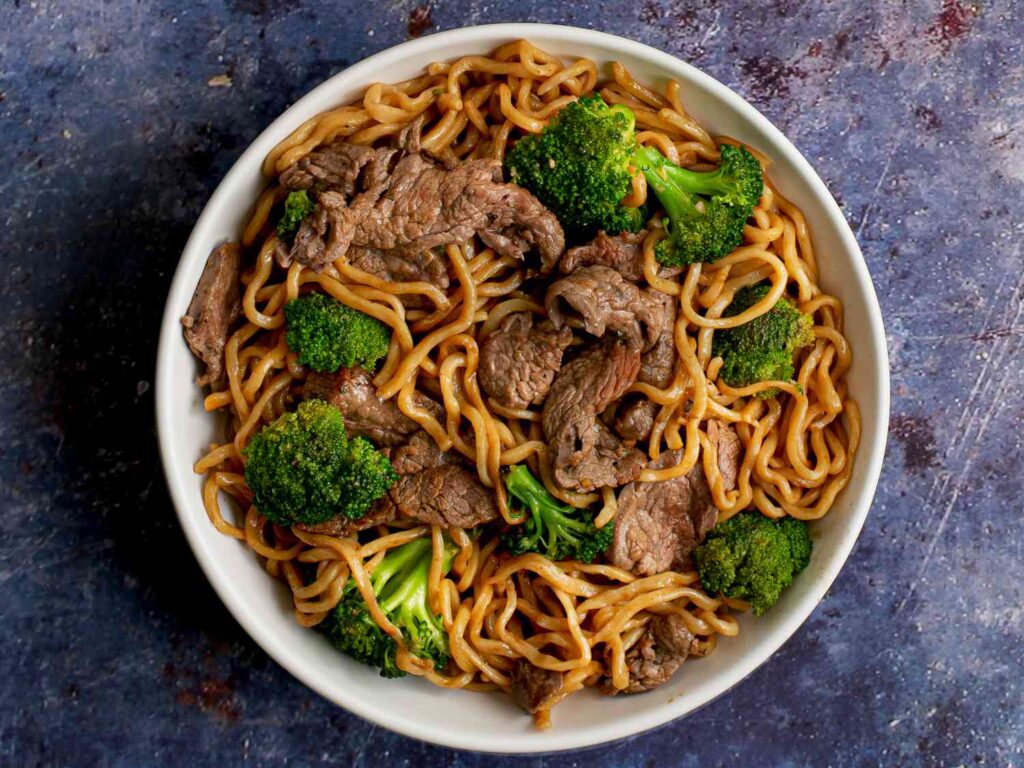
SEE ALSO:
What Meat Goes with Beef Lo Mein?
- Beef: Flank steak, skirt steak, ribeye, or top sirloin will all work great in this recipe. Whatever cut you choose, make sure the beef achieves a nice golden colour. It will have so much flavour.
- Chicken: If you are going to opt for chicken, use boneless breasts. Skip the browning step, but still slice the chicken into two-inch pieces. When sauteeing your chicken slices in your sauce, make sure to cook them all the way through!
- Veggie Lo Mein: If you are skipping out on the meat, you can always make our incredible Veggie Lo Mein.
The Difference between Beef Lo mein and Beef Chow Mein
The main factors that differentiate Beef lo mein from beef chow mein are:
- The cooking method: Chow mein and lo mein have similar recipes which equate similar ingredients. However, the cooking methods for each of them are completely different. Chow mein noodles are soaked in hot water to soften them up before stir-frying. The process of stir-frying fully cooks the noodles along with the remaining ingredients. While for lo mein noodles, the noodles are completely cooked before getting mixed in with the meat, vegetables and sauce. Instead of getting stir-fried, the lo mein ingredients are lightly mixed and tossed.
- The work technique: The methods of cooking both dishes in a wok are quite different. Making chow mein noodles in a wok involves using a small amount of oil in a very hot wok to lightly fry the ingredients while stirring briskly. But as for lo mein, the noodles are already cooked and are simply mixed and tossed with the rest of the ingredients instead of fried.
- The sauce: Chow mein is more of a dry noodle dish with an extremely light and delicate sauce. if any sauce at all. Lo mein is a saucy noodle dish that depends on a rich sauce for much of its flavour.
- The texture: Chow mein noodles tend to be crunchier than lo mein noodles due to the way they are cooked. Lo mein noodles are typically smoother and slightly chewier because they are fully cooked before being tossed with any extra ingredients and sauce. The noodles used to make a lo mein dish must also be thick and sturdy enough to support the weight of extra sauce.
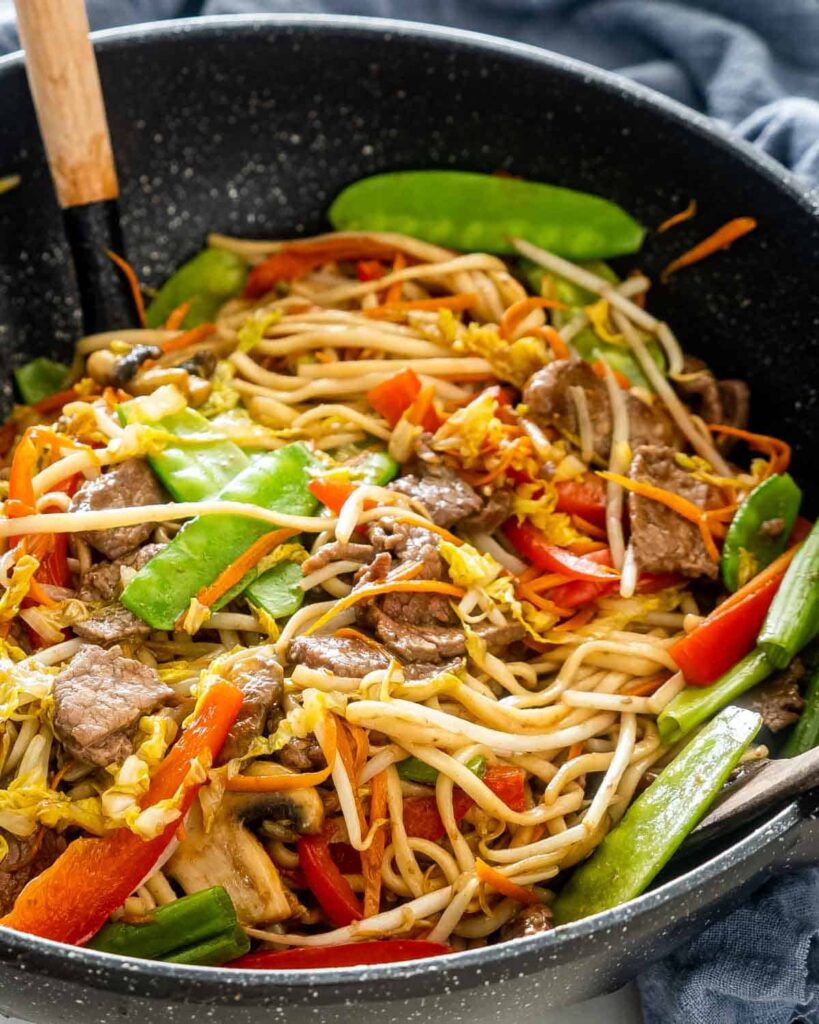
READ ALSO: Chow Mein vs Lo Mein: A Review of Chinese Noodles
Beef Lo mein Recipe
Ingredients
Ingredients for the Stir-Fried Noodles
- Lo Mein Noodles: At the heart of our dish lies the noodles, providing that satisfying chewiness that complements the tender beef and vegetables. Fresh lo mein noodles or dry egg noodles will work. For those with dietary preferences, feel free to explore grain-free options such as Jovial Cassava Spaghetti Noodles, shirataki noodles, konjac noodles or hearts of palm noodles.
- Flank Steak or Sirloin: Thinly sliced against the grain, the beef is the star of this show, infusing the dish with rich and savoury flavours. Trim off any excess fat for a leaner and more succulent result.
- Salt and Black Pepper: Seasoning the beef with salt and black pepper enhances its natural taste and prepares it for cooking.
- Tapioca Starch: Coating the beef with tapioca starch (or arrowroot starch or cornstarch) helps retain its moisture and results in a delightful velvety texture.
- Cooking Oil: For a tantalizing stir-fry, you will need cooking oil to cook the beef and vegetables. Use your preferred oil, such as vegetable oil, peanut oil, or sesame oil.
- Broccoli Florets: These vibrant green florets bring a fresh and nutritious element to the dish, elevating it to a wholesome meal.
- Fresh Ginger and Garlic: To infuse the Beef Lo Mein with an aromatic punch, we’ll use fresh ginger and garlic, adding depth and complexity to the overall flavour profile.
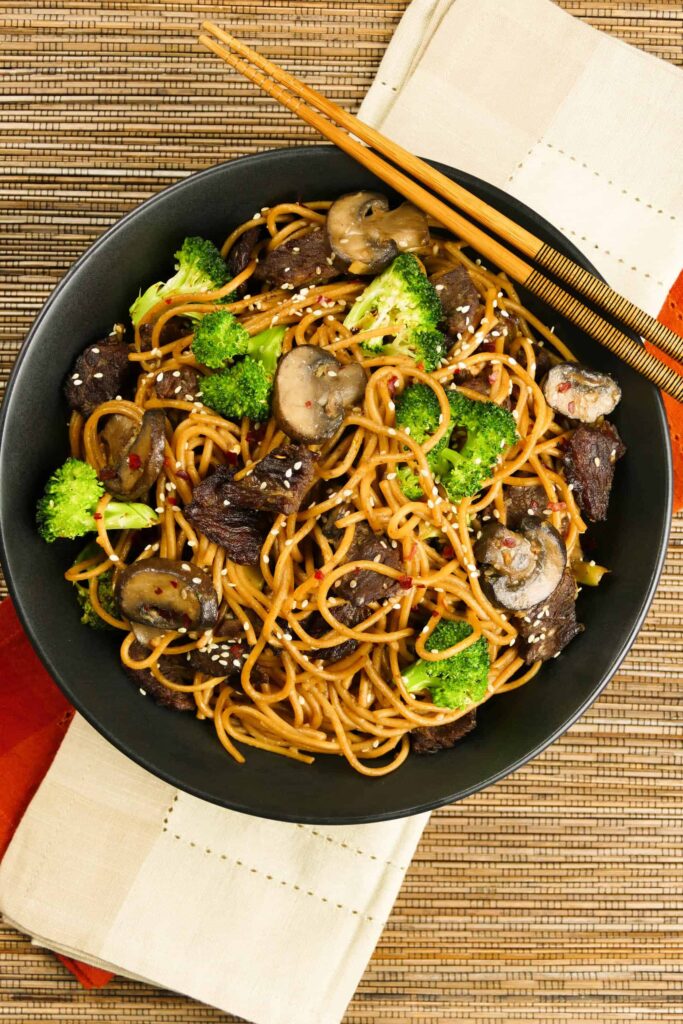
For the Sauce:
- Coconut Aminos: Our base for the savoury sauce, coconut aminos offers a gluten-free alternative to soy sauce without compromising on taste. Gluten-free tamari or low-sodium soy sauce works too.
- Oyster Flavored Sauce: We’ll include oyster-flavoured sauce for that extra burst of umami. You can also opt for a vegan oyster-flavoured sauce, such as Naked Natural Foods’ Organic Vegan Oyster Sauce.
- Rice Wine, Mirin, or Dry Sherry: This ingredient adds a delightful tanginess to the sauce, balancing out the flavours.
- Honey or Coconut Sugar: A touch of sweetness perfectly complements the savoury notes. For a lower-sugar option, try maple syrup or a brown sugar substitute.
- Toasted Sesame Oil: Just a hint of toasted sesame oil imparts a nutty aroma, enhancing the dish’s overall taste.
- Tapioca Starch (again): To thicken the sauce and create a luscious glaze, we’ll use tapioca starch (or arrowroot starch or cornstarch).
- Water: To achieve the perfect sauce consistency, we’ll add water, adjusting as needed to reach the desired thickness.
- Fish Sauce (optional): Fish sauce is a fantastic addition for those who enjoy an extra umami kick. If you’re not a fan of fish sauce, you can try a vegan fish sauce alternative like Ocean’s Halo.
- Thai Chili Garlic Paste, Red Pepper Chili Flakes, or Sriracha Sauce (optional): For spice enthusiasts, these options will add a fiery kick to the dish. Adjust according to your preference.
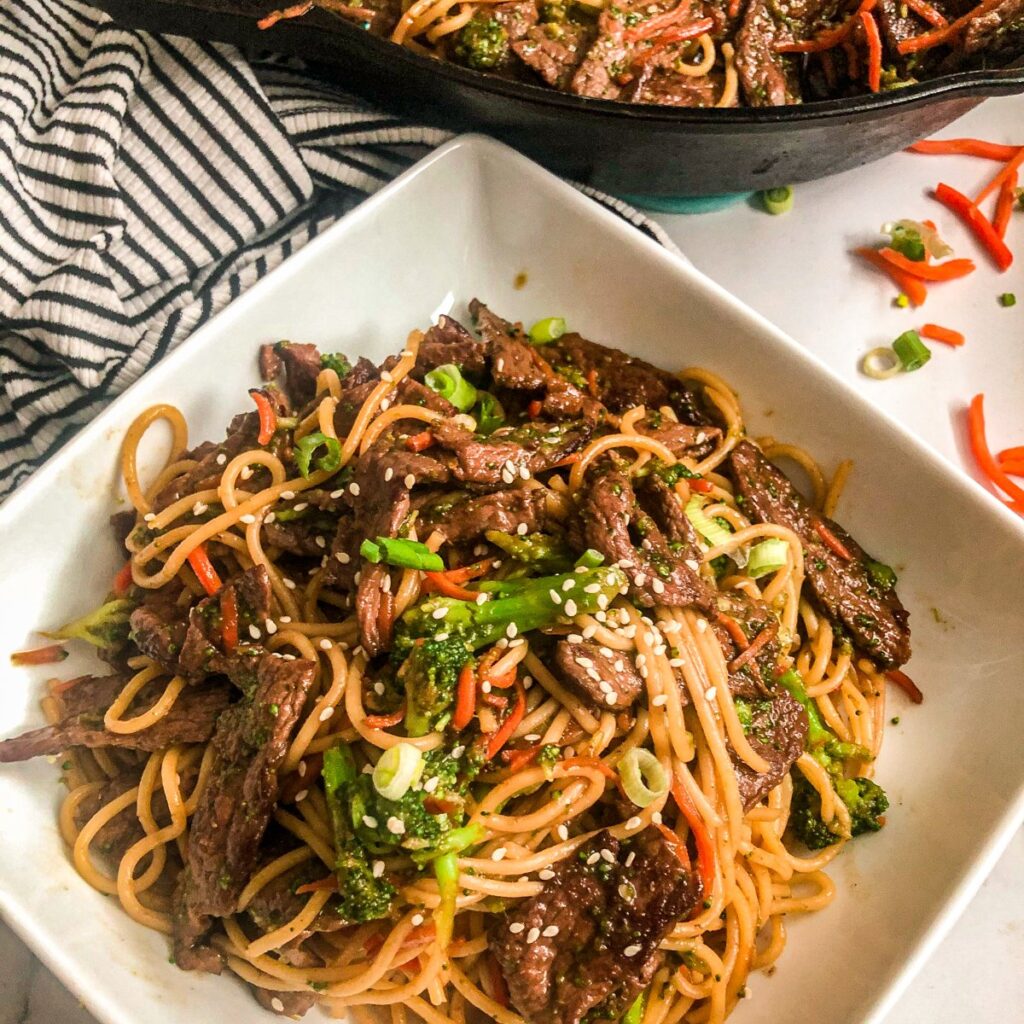
Instructions
- Place the beef in the freezer for 15 minutes to firm up for easier slicing. Cut the beef across the grain into very thin (1/4-inch or smaller) slices. Cut any long slices in half crosswise (each strip should be around 3 inches or so long).
- Place the beef in a medium bowl. In a small bowl, stir together the baking soda and 2 tablespoons of water. Pour over the beef and toss to coat. Let sit for 5 minutes (this helps to tenderize it).
- Meanwhile, cook the noodles just until al dente in a large pot of salted water. Drain and rinse under cool water. Set aside.
- In a small bowl or larger liquid measuring cup, stir together the soy sauce, hoisin, garlic, ginger, and red pepper flakes. Keep handy near the stove.
- Heat the oil over medium-high in a wok or large, nonstick skillet. Add the beef and cook until crisp on the outside but still pink on the inside, about 3 minutes. The beef will give off liquid, which is fine. Stir in 1 tablespoon of the sauce and let cook for 30 seconds. With a large spoon, scoop the beef onto a plate (any cooking juices left behind will cook away).
- Add the carrots, broccoli, and bell pepper. Cook until crisp-tender, about 2 minutes. Stir in the remaining 4 tablespoons (1/4 cup) of water and let the vegetables steam until the broccoli turns bright green and most of the liquid has cooked away, about 2 minutes more.
- Stir in the water chestnuts, half of the green onions, and 2 tablespoons of the soy sauce mixture and let cook for 30 additional seconds.
- Reduce the heat to medium. Add the noodles and beef and pour the remaining soy sauce mixture over the top. With tongs, stir and toss until the noodles are heated through.
- Drizzle the sesame oil over the top (if using) and sprinkle on the remaining green onion. Toss to combine. Enjoy!
SEE ALSO: How to Prepare Chicken Chow Mein With The Best Sauce
Beef Lo Mein Serving Suggestions
You can serve various cuisines and dishes with beef lo mein.
1. Chinese vegetable spring rolls
Chinese vegetable spring rolls make the perfect side to serve with a dish of beef Lo Mein. They are easy to prepare and fulfilling. The crispy rolls make the perfect combination with soft beef lo mein.
They both mix well to make your meal more fulfilling. You can include some sauce dips with this meal to make it better. These vegetable spring rolls will make you want a second serving, and the veggies inside your rolls perfectly match your lo mein veggies.
2. Sauteed Cucumber
This serving may seem a bit strange compared to the usual servings you are used to. But be rest assured, your taste buds will adjust to it after a few bites. Eating sauteed cucumbers with beef lo mein may sound as if you are definitely used to having them pickled or raw.
However, this preparation brings unique flavours supporting the lo mein. To have a perfect overall meal, keep the cucumbers crispy and fresh, which means the cucumbers are drained of water.
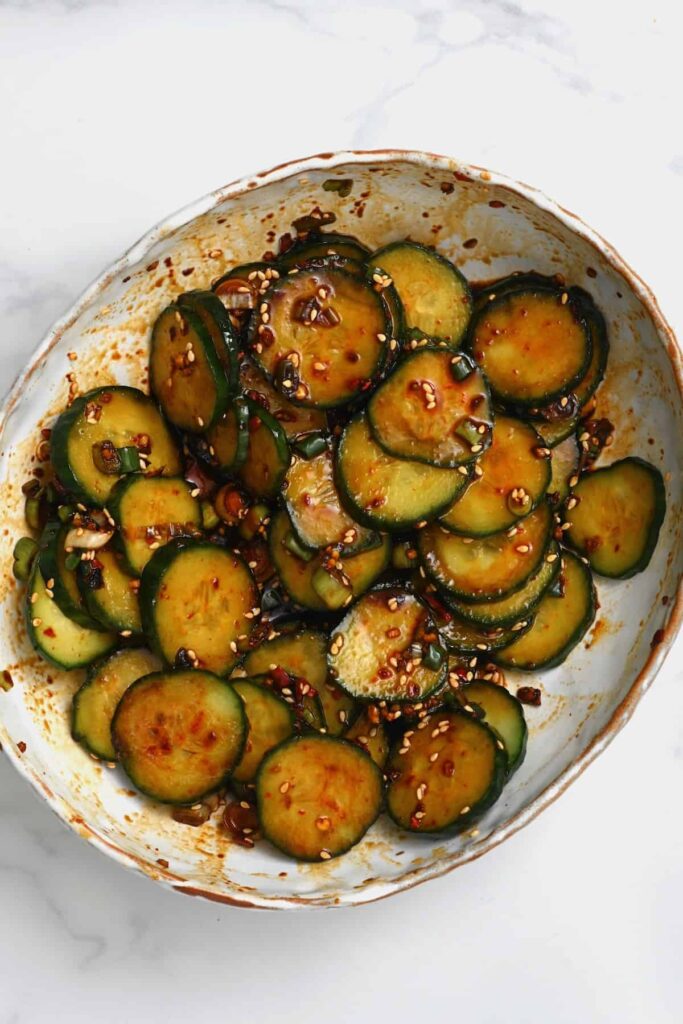
3. Brown Rice
Brown rice is a staple of Chinese cuisine. Combining these two may feel weird as they are both known to be heavy meals. But having the two meals mixed together can be quite fulfilling.
The brown rice has an intense flavour, so when mixed together, the hearty aroma blends with the beef lo mein, making it more flavourful. To enhance the dish, include some veggies on the side.
4. Garlic Sesame Broccoli
You can whip this up if you have some fresh leftover broccoli at home. This side cuisine can be done in 5 min.
The garlic flavour does some wonders in your beef lo mein, not to mention how crunchy the broccoli feels with the nutty and hearty sesame flavours and the taste it gives after mixing them together is heavenly enough to make your guest want more.
5. Baked Chicken Breast
This is a side dish you can make when you are short on time. It is also a healthy option compared to fried chicken, and it goes well with beef lo mein. To make this dish, you simply bake your chicken breasts in the oven until they are cooked through.
Then, you can either slice them or shred them into bite-sized pieces. You can also add a bit of garlic powder, onion powder, and paprika to the chicken breasts before baking them.
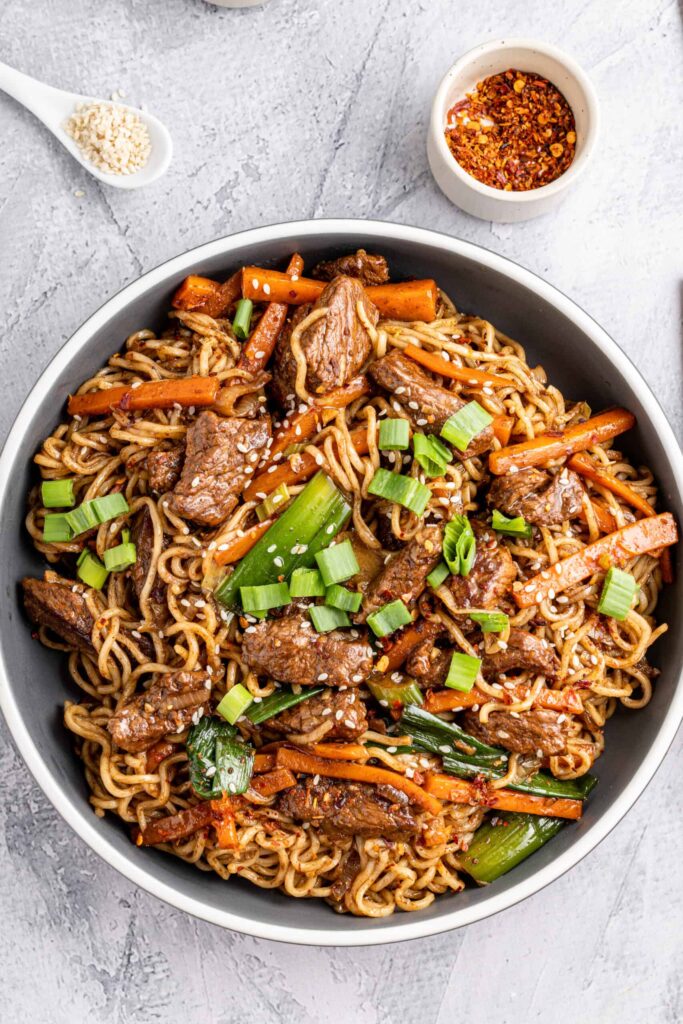
READ ALSO: Smoked Brisket Recipe
How to store Beef Lo mein
Leftover Beef lo mein will last in the fridge for up to 4 days in an airtight container. Reheat either on the stovetop or in the microwave. Note that the noodles can soak up the sauce so you may want to add extra or a little broth when reheating.
Can Beef Lo Mein be Frozen?
Yes, it can be frozen. You can freeze lo mein for up to 6 months (4 months if you have added protein). But freezing and reheating the beef lo mein with the vegetables will lose a lot of their crispness and texture.
Calories in Beef Lo Mein
Lo mein, with beef, contains 258 calories per 200 g serving. This serving contains 5.5 g of fat, 19 g of protein and 32 g of carbohydrate. The latter is 4.2 g of sugar and 2 g of dietary fibre. The rest is a complex carbohydrate. Lo mein, with beef, contains 1.4 g of saturated fat and 30 mg of cholesterol per serving.
Conclusion
Beef lo mein stands as a testament to the marriage of simple ingredients and intricate flavours. Its popularity endures for good reason, offering a satisfying and delicious experience that can be enjoyed in the comfort of your own kitchen.
Armed with the knowledge of its origins and preparation, you now have the tools to master this beloved Chinese-American classic. So, don your apron, fire up the wok, and savour the delightful simplicity of beef lo mein—a dish that continues to bring joy to tables around the world.
FAQs
What does Lo Mein stands for?
In Cantonese, lo mein means “mixed noodles”. It’s pronounced “lao mian” in Mandarin and translates exactly the same. It’s egg noodles mixed with sauce – somewhat similar to chow mein, but not quite.
What country is beef lo mein from?
Lo Mein is a noodle dish that originates from China but has been very Americanized. The Americanized version is a combination of stir-fried noodles, meat, and vegetables.
